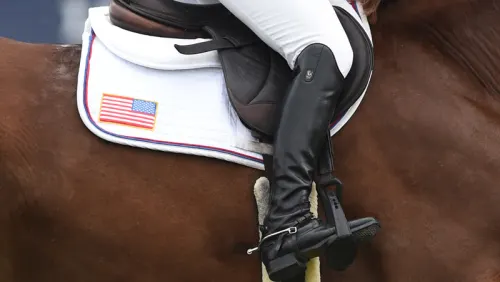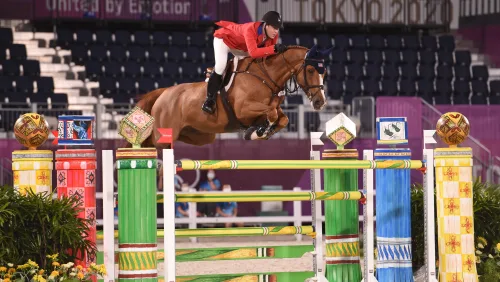Thermal, Calif.—Jan. 18
As lead clinician in California’s second USHJA Gold Star Clinic, Katie Monahan Prudent kicked things off with a story. A few years ago, she had a horse that stopped at the water. “I’m getting old, and I don’t ride as well as I used to,” said the renowned international show jumper and coach. So, she chose not to tackle the issue herself and went in search of a rider who could. Mentor George Morris had implored her to go with an American rider instead of a European. “So, I walked around the show grounds [in Florida] all day trying to find someone who could hop on that horse and make it go.”
“I could not find one,” she told the rapt audience of 24 junior and amateur riders who’d earned a spot in the clinic through the USHJA Zone Jumper Championships. “I cried. I wanted to find an American who was strong and brave enough to fix it, but the only way you get that way is by riding horses like that one.”
And therein lies Prudent’s main motivation for accepting the Gold Star assignment. She’s well known for asserting that too many young American riders are “coddled” by always riding finished, obedient horses, and she feels professionals are too quick to hop on and solve a problem with their student’s horse. And with that aspect of the sport in mind, she set about solving it.
Training Versus Competing
“Ride every horse like you are going to teach it to do what you want it to do, and without getting angry,” she said during a talk titled “The Importance of Training Versus Competing” on the first night of the four-day clinic.
“Training horses is still my greatest pleasure,” Prudent said. “Any student that comes to work with me, we work together to make that horse better. That’s the fun of training. Train a horse with a purpose.”
She urged attendees to eavesdrop at the back gate when Beezie Madden, Lauren Hough or their Olympic contemporaries finish a round. “They never say, ‘The horse did this or that.’ Without exception, they say, ‘I should have done this or that better.’ It’s the rider’s responsibility to make the horse better. All your training should have the idea that you are getting inside your horse’s head and figuring out how to make him do what you want.
“Training yourself as a rider is very important, too.”

Katie Prudent encouraged riders like 17-year-old Rachel Long to always focus on training rather than competing. Kim Miller Photos
Training time should always trump competing time, Prudent said. “When we are showing, I like to study every round of every horse and rider. When the show is over, we go to work on everything that went wrong.”
She gave the example of a young horse who repeatedly had the first element of a double combination down during a show. The next week at home, the youngster saw a lot of doubles, with poles before, in the middle and after each jump to “make him study each element.”
“Let the performance of your horse dictate what you do after the show.”
ADVERTISEMENT
And horses weren’t the only ones who were given plenty of homework after a show. In her barn, students who get jumped loose over fences spend the off weeks riding without stirrups, including jumping, to build a more secure position.
Katie and co-presenter USEF Youth Chef d’Equipe DiAnn Langer shared that “talent” was the last of five characteristics as critical to successful career with horses. Motivation, horse management, picking the right horse and managing emotions topped Katie’s list; DiAnn’s list had emotional control in the #2 slot. No matter, the point was that details mattered in every minute spent on, with or related to the horse.
Cool Morning, Hot Horses
Gold Star attendees rose early Friday morning to tend to those details, arriving at the groom-less stabling area, supervised by Colleen Reed, at 6 a.m. to feed, water, muck and prepare for the flat-work sessions that began at 7:15 a.m.
Collection, extension and lateral work comprised the framework as six groups of four worked with Prudent. Three sets of poles, one set on a curve, and two on a straight line, were later incorporated to take control of the horse and its body parts to the next level. Poles are great practice because the rider can compress or extend the approach stride without risk of making a mistake that could be dangerous going to a jump.
“Whatever the horse does wrong, do the opposite” was a main theme of the morning. If the horse rushed through the poles or squirted away at the end, riders were to halt. If the horse tended toward pokey gaits, Prudent advised schooling him at a slightly faster than normal pace. If too fast, then work slightly under a normal pace.
Following several days of heavy rain, the cool sunny morning saw ample high spirits, allowing Prudent to share tips on the tricky act of training hot horses. Teaching them to accept leg pressure is essential, she said. So is “allowing” the horse to go forward with relaxation of rein contact, versus “making him go” with more extreme releases or sudden, unaccepted leg pressure likely to set off a tantrum. A light seat is important, too.
One hot horse was coaxed into a more relaxed, supple frame by first getting him to bend in the neck. Coaching an opening outside rein and indirect inside rein, (“inside rein toward your outside hip”), Prudent helped the rider gain a slight bend in the sensitive and strong horse’s neck. When the horse was looking slightly to the inside, a touch of inside leg helped extend that bend through the body for relaxation and more control.
The previous afternoon’s unmounted sessions delved into pedigree and conformation and how they affect biomechanics, all in the context of how horse management can maximize or minimize those characteristics.
Prudent built upon that by describing the fitness aspect of flatwork. “You are a trainer and conditioner of your horse,” she said.

Gracie Belmont, 15, got high praise for being a stronger rider and getting her horse, Colt 45, to do what she wanted him to do.
She explained that a stiff neck and high head carriage usually causes a stiff back. The right combination of leg and rein contact to lower the horse’s frame and engage its hind end helped to relax, loosen and stretch those muscles.
“A slow sitting trot is like running in place at the gym,” Prudent said. In horses, it develops back muscles and is a good exercise for such horses. The ultimate example of that is trotting in place—piaffe, she explained. “It’s harder to find a horse that can piaffe than it is to find a Grand Prix (jumping) horse because it takes incredible strength and collection,” she said. Conditioning flat work is as important for the older horse that needs to maintain muscle as it is for a young horse building it.
ADVERTISEMENT
Exerting control over the horse’s hindquarters was one of many exercises that clarified the connection between flat work and jumping a course. Asking one group to do a 180 turn by “doing a sort of turn on the haunches at the trot,” Prudent told riders to push the hindquarters off their outside leg, striving to get the hind legs crossing over each other. Riders who could do this effectively had a stronger and quicker response than those who couldn’t.
When they moved to three poles set on a half-circle, hindquarter control was a big determinant in whether riders could fulfill Prudent’s requests for four, then three and five strides between each. On course, a planned track changes radically if the horse is bulging out in either direction.
Along with building muscle, working on hindquarter control through curved tracks helps a rider and the veterinarian understand what’s going on in their horse’s body. Bulging out, cutting in or swapping leads are details that could help prevent or diagnose a physical problem.
As the courses of poles got longer and more complicated with more changes of direction and striding, and halts on a straight line, the term “bird brain” arose occasionally.
“At this level, for the rider, it’s about concentration and discipline, not forgetting any of the details,” Prudent said.
Young amateur Sloan Elmassian was thrilled with the clinic already, even though she’d started the day by having Katie lengthen her stirrups two holes. She’s 5’2″ on “a good day” and rides a big horse, yet she appreciated that “Katie did that and still held me to a higher standard,” Elmassian said. “No excuses. She said just go out there and do it.”
Prudent’s Tips:
Tack: Prudent likes to train her horses in a standing martingale, “but not too tight.” “It teaches them to never flick their head and stabilizes their head and neck carriage.”
Knuckles In the Neck: As one horse flung its head and tried to scoot away after a line of poles, Prudent told the rider to bury her knuckles into the neck. “That way the horse is fighting against himself and not you.” Once the horse came back to that pressure, the rider could resume carrying her hands normally.
When a horse is fussy with its head, calling the dentist is the first thing to do. “Often that’s your horse telling you something is hurting,” Katie said. “Maybe he has a wolf tooth or ulcers in his mouth.”
Leg Position: Long leg, sunken heel with the ball of the foot straight in the stirrup. Keeping only the toe in the stirrup poses too high a risk of losing it. No pinched knees because it prevents the lower leg from wrapping round the horse and conveying aids effectively.

















